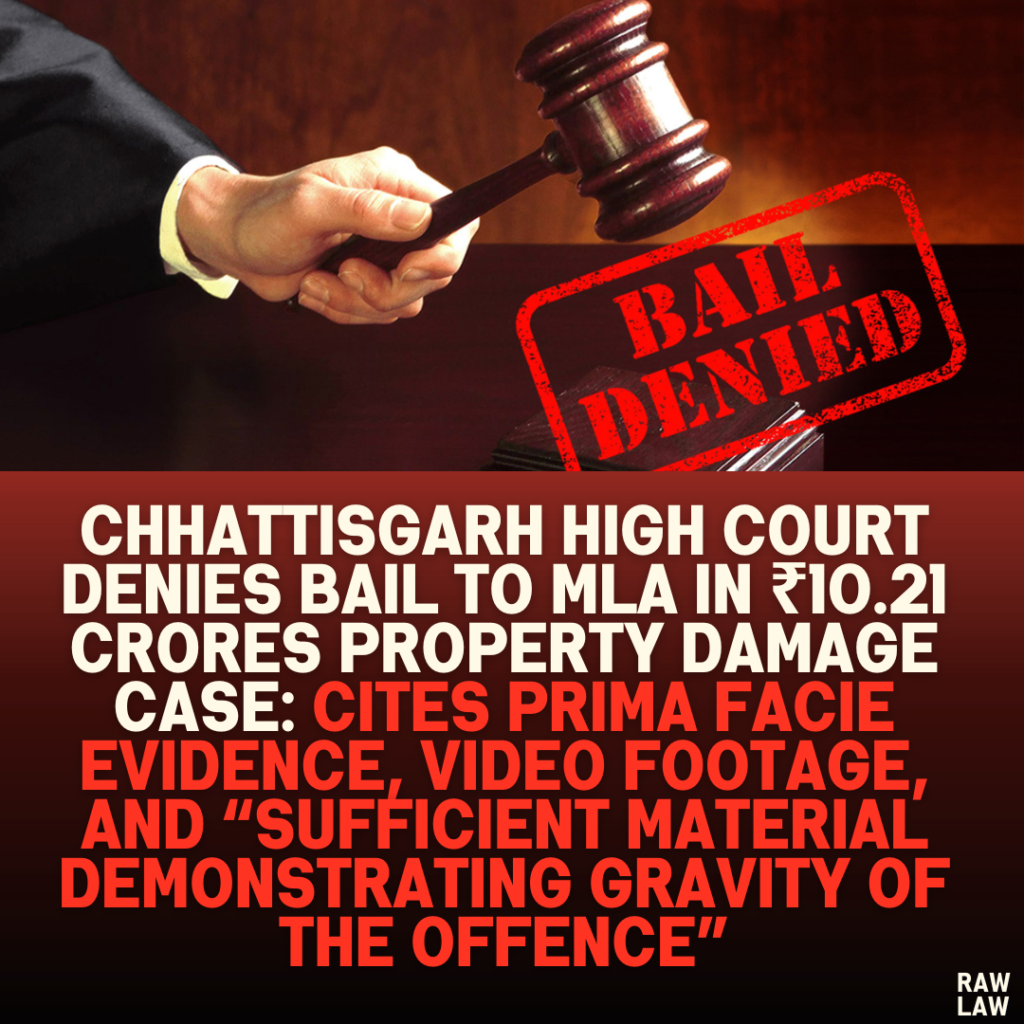Court’s Decision
The Chhattisgarh High Court rejected the bail plea of the applicant, a Member of the Legislative Assembly, who was accused of conspiring, instigating violence, and supporting acts of vandalism and arson during a protest. The court highlighted the grave nature of the allegations, the prima facie evidence against the applicant, and the extensive damage caused to public property. The court observed, “The presence of the applicant is admitted in the press conference done by him as reflected in the video attached with the case diary. Thus, there is sufficient material to prima facie record finding regarding involvement of the applicant in the crime in question.”
Facts
- On June 10, 2024, a congregation was organized by a community to protest the vandalism of their monument. The event, initially permitted with conditions to maintain peace, escalated into violence.
- The mob caused significant damage, including the destruction of 134 motorcycles, 29 private vehicles, 17 government vehicles, and the complete burning of three fire brigade vehicles. The total damage was estimated at ₹10.21 crores.
- The applicant was not an organizer or part of the protesting community but was alleged to have supported the congregation and provided financial aid to escalate the unrest.
- The applicant was arrested on August 17, 2024, based on evidence of his involvement in the conspiracy, including video evidence and corroborative statements from co-accused.
Issues
- Whether the applicant’s alleged involvement and presence at the protest demonstrated sufficient grounds for denial of bail.
- Whether granting bail would obstruct justice, given the severity of the alleged offences and their impact on public order.
Petitioner’s Arguments
- The applicant claimed he was falsely implicated due to political vendetta by rival parties.
- He argued that his arrest, based only on suspicion, lacked corroborative evidence linking him to the violence.
- He denied organizing or addressing the congregation and claimed he left the venue before the violence began.
- The applicant’s counsel emphasized that there was no direct evidence of him inciting the mob or providing financial aid.
- He argued that his continued detention was unnecessary as the investigation was complete, and no recoveries were pending.
Respondent’s Arguments
- The prosecution asserted that video evidence, photographs, and co-accused statements indicated the applicant’s direct involvement in the conspiracy.
- It was alleged that the applicant advised organizers to escalate the protest and offered financial assistance to disrupt public order.
- The prosecution argued that the applicant’s public presence and press statements corroborated his role in supporting and inciting the congregation.
- The violent incident caused unprecedented damage to public property, jeopardized law and order, and required stringent judicial scrutiny.
Analysis of the Law
The court considered established principles for granting bail, particularly from the rulings in Ramesh Bhavan Rathod v. Vishanbhai Hirabhai Makwana (Koli) and Prasanta Kumar Sarkar v. Ashis Chatterjee:
- The nature and gravity of the offence were key considerations, as the applicant’s alleged actions had resulted in large-scale violence.
- The evidence against the applicant, including his presence at the scene and his statements, demonstrated prima facie involvement.
- The risk of tampering with evidence or influencing witnesses weighed against granting bail.
The court emphasized the seriousness of the offence, which involved substantial damage to public property, and noted that bail in such cases should be granted only after thorough consideration of all relevant factors.
Precedent Analysis
The court relied on:
- Ramesh Bhavan Rathod v. Vishanbhai Hirabhai Makwana (Koli): This case highlighted that bail should be granted only after weighing the gravity of the offence, evidence, and risk factors.
- Arnesh Kumar v. State of Bihar: Emphasized the role of judicial discretion in cases involving grave accusations.
- Prasanta Kumar Sarkar v. Ashis Chatterjee: Provided guidelines on factors to be considered when granting or denying bail.
Court’s Reasoning
- The court found that the applicant’s involvement in the violent incident was prima facie supported by:
- His press statements and video evidence acknowledging his presence.
- Statements from co-accused implicating him in the conspiracy.
- The court noted the applicant’s admission in a memorandum statement that he visited the congregation, although he denied direct involvement in the violence.
- The evidence suggested that the applicant’s advice and assurances emboldened the protesters, leading to the large-scale violence and property damage.
- The court emphasized that the extent of damage caused and the disturbance to public order required judicial prudence, and bail could not be granted lightly in such circumstances.
Conclusion
The High Court rejected the bail application, holding that sufficient evidence linked the applicant to the alleged offences. The court stated, “The quality of the material collected by the prosecution regarding conspiracy done by the applicant are defences of the accused which require thread-baring analysis of evidence, which can be done by the trial court only after recording of evidence.”
Implications
- The decision reinforces the judiciary’s firm stance on offences involving public unrest and damage to property.
- It underscores the importance of balancing individual liberty against societal interests and public order in bail matters.
- The ruling may serve as a precedent for handling similar cases involving allegations of conspiracy and large-scale violence.




Pingback: Jammu & Kashmir and Ladakh High Court Dismisses Petition on Rehbar-e-Taleem Teacher Selection: Abolition of ReT Scheme Renders Tentative Panel Legally Void and Further Litigation Futile - Raw Law